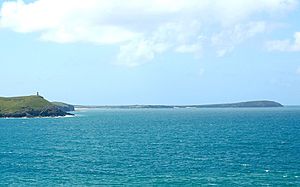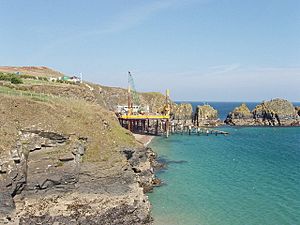Trevose Head facts for kids
Trevose Head is a famous piece of land that sticks out into the Atlantic Ocean in north Cornwall, United Kingdom. Its name, in the Cornish language, means "farm of the wall's headland." This amazing spot is about 5 miles (8 kilometers) west of a town called Padstow.
A popular walking trail, the South West Coast Path, goes all around Trevose Head. This area is part of the Cornwall Area of Outstanding Natural Beauty, which means it's a special place with beautiful landscapes. On a clear day, you can see almost the entire north Cornwall coast from here! Looking north, you can see all the way to Hartland Point in Devon, which is about 40 miles (64 km) away. If you look south, you can see past St Ives to Pendeen Watch, about 35 miles (56 km) away.
Contents
History of Trevose Head
Trevose Head has some interesting history. You can find the old ruins of St Constantine's chapel near the Trevose Golf Club. This club is located between Constantine Bay and Mother Ivy's Bay, close to Booby's Bay.
Trevose Head Lighthouse
The Trevose Head Lighthouse stands tall on the north-west side of the headland. It is looked after by an organization called Trinity House. This lighthouse first shone its light on December 1, 1847. At first, it had two lights, one above the other, but the lower light was stopped in 1882. The people who lived and worked at the lighthouse left on December 20, 1995, after the lighthouse became automated. This means machines now run it.
Padstow Lifeboat Station
The Padstow lifeboat station is located on the east side of Trevose Head. A lifeboat helps people who are in trouble at sea. The first lifeboat was set up in Padstow even before 1825! In 1967, the lifeboat station moved from Hawkers Cove to Trevose Head. This move happened because the River Camel was getting too much sand in it, making it hard for the lifeboat to get out. The current lifeboat station building was finished in July 2006 and started helping people shortly after.
Natural Wonders of Trevose Head
Trevose Head is part of a special area called the Trevose Head and Constantine Bay Site of Special Scientific Interest (SSSI). This means it's important for both its plants and animals, and its interesting rocks and landforms.
Plants and Wildlife
You can find some unique plants growing on the cliffs here. For example, wild asparagus grows on the cliffs of Dinas Head. You might also spot shore dock at the bottom of the cliffs. The tall cliffs are also a very important home for many kinds of birds. These include fulmars, razorbills, and guillemots. These birds often build their nests on the cliffs.



